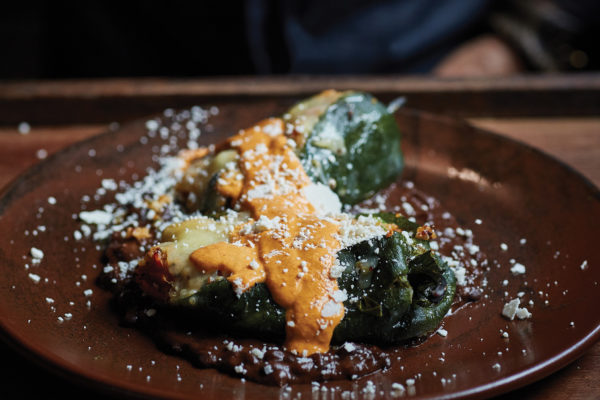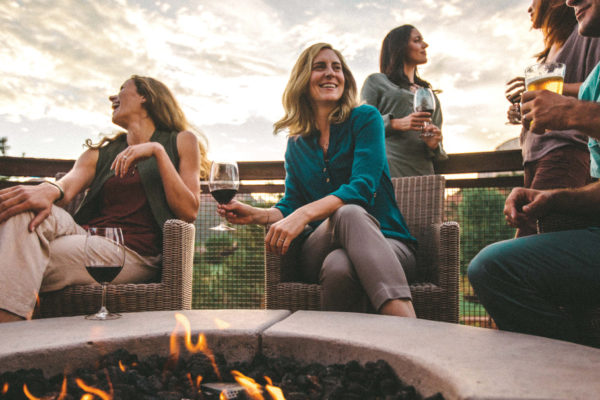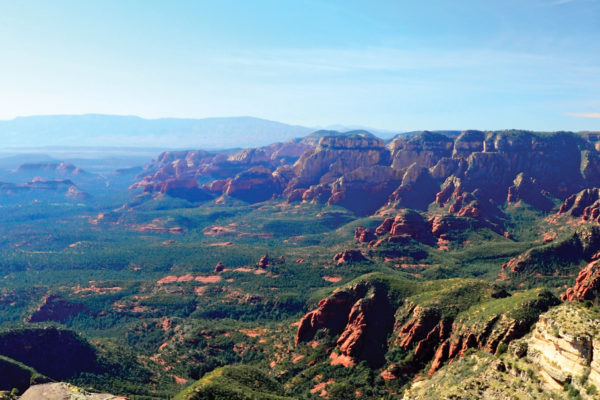DESERT BOTANICAL GARDEN
Don’t get us wrong: We don’t think there’s any landscape on Earth that’s as beautiful as Sedona’s red rocks, but sometimes you just want to spend a little time in a quintessentially desert environment. That’s when we wander the trails at Desert Botanical Garden. Five trails lead you through a wonderland of desert plants (50,000 in all) nestled between the Papago Buttes. The Desert Discovery Loop Trail showcases desert plants from around the world and is one of our favorite walks. And we love to visit the garden during one of its special events. We recommend Electric Desert: A Light and Sound Experience by Klip Collective, which opens Oct. 12. The exhibit, the brainchild of Klip Collective Creative Director Ricardo Rivera, features six site-specific locations that turn the plants into living canvases using lights, projection mapping and an original soundtrack. It all takes place after dark, making it even more enticing, especially when it’s hot outside. “It’s an experiential journey,” says Ricardo, who is based out of Philadelphia. “We will be transforming the garden with light and sound. There’s no literal narrative, but it will be a magical journey for people to engage in and experience.” Make an afternoon or evening out of your visit by reserving a table at Gertrude’s, the garden’s award-winning restaurant. If the weather cooperates, request a table outside. And if you’ve started shopping for the holidays, pop into the garden shop for desert and garden-themed gifts. Desert Botanical Garden is located at 1201 N. Galvin Pkwy. in Phoenix. The garden is open daily from 8 a.m. (7 a.m. May through September) until 8 p.m. Admission is $24.95 for adults and $12.95 for children ages 3 to 17. Electric Desert is on display until May 12. For more information, visit dbg.org or call 480-941-1225.
HEARD MUSEUM
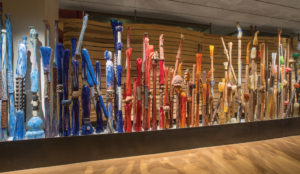 For northern Arizonans looking to learn more about the native cultures in our area, the Heard Museum is a great place to start. Founded in 1929 by Dwight and Maie Bartlett Heard as a gathering place for locals and a way to showcase the items the Heards had collected on their travels, the museum now includes 12 exhibit galleries and 44,000 objects housed in 30,000 square feet of space. Start your visit with a tour, which lasts about 45 minutes and begins in the 10,000-squarefoot HOME exhibit. It’s here that you’ll learn about Arizona’s 22 tribes, says Caesar Chaves, the museum’s director of creative design and marketing. You’ll also find 340 Hopi katsina dolls from the Goldwater and Fred Harvey Company collections. After the tour, take the time to wander the campus. Check out the two cafes and two shops, one featuring books and the other offering Native American art of the same quality that is housed in the museum. Caesar says people are often surprised to see the amount of contemporary Native American art at the museum. “History hasn’t stopped being made,” he says. “We have items on display from 400 A.D. up until today. Native American people are still vibrant and active and creating amazing art. In fact, I’d say the art is enjoying a booming renaissance right now.” The museum hosts several events throughout the year, but the big one is the Heard Museum Guild Indian Fair & Market, which happens March 2 and 3, 2019. It features 600 artists along with music, entertainment and food. Beginning Oct. 29 and running through Feb. 3, 2019 is Yua: Henri Matisse and the Inner Arctic Spirit. The exhibit explores the little-known story of how French painter Henri Matisse was inspired by the masks created by the Inuit people. (We aren’t talking small wall masks – some are as tall as 4 feet.) The masks were made in pairs, and some have been separated for more than 100 years. They will reunite during this exhibit alongside drawings from Matisse that have never been displayed in the U.S. “If you’re only going to visit the Heard once in your life, do it during this exhibit,” says Caesar. One more insider tip: The Heard Museum is open the first Friday of each month from 6 to 10 p.m. free of charge during Phoenix’s First Fridays Art Walk. And unlike many museums, the Heard is open Mondays, one of the quieter times to visit. The Heard Museum is located at 2301 N. Central Ave. in Phoenix. It’s open Monday through Saturday, 9:30 a.m. to 5 p.m. (10 p.m. the first Friday of the month), and Sunday, 11 a.m. to 5 p.m. Tickets are $18 for adults, $13.50 for seniors, $7.50 for students and children ages 6 to 17, and free for children 5 years and younger. Tickets are also free for American Indians. For more information, visit heard.org or call 602-252-8840.
For northern Arizonans looking to learn more about the native cultures in our area, the Heard Museum is a great place to start. Founded in 1929 by Dwight and Maie Bartlett Heard as a gathering place for locals and a way to showcase the items the Heards had collected on their travels, the museum now includes 12 exhibit galleries and 44,000 objects housed in 30,000 square feet of space. Start your visit with a tour, which lasts about 45 minutes and begins in the 10,000-squarefoot HOME exhibit. It’s here that you’ll learn about Arizona’s 22 tribes, says Caesar Chaves, the museum’s director of creative design and marketing. You’ll also find 340 Hopi katsina dolls from the Goldwater and Fred Harvey Company collections. After the tour, take the time to wander the campus. Check out the two cafes and two shops, one featuring books and the other offering Native American art of the same quality that is housed in the museum. Caesar says people are often surprised to see the amount of contemporary Native American art at the museum. “History hasn’t stopped being made,” he says. “We have items on display from 400 A.D. up until today. Native American people are still vibrant and active and creating amazing art. In fact, I’d say the art is enjoying a booming renaissance right now.” The museum hosts several events throughout the year, but the big one is the Heard Museum Guild Indian Fair & Market, which happens March 2 and 3, 2019. It features 600 artists along with music, entertainment and food. Beginning Oct. 29 and running through Feb. 3, 2019 is Yua: Henri Matisse and the Inner Arctic Spirit. The exhibit explores the little-known story of how French painter Henri Matisse was inspired by the masks created by the Inuit people. (We aren’t talking small wall masks – some are as tall as 4 feet.) The masks were made in pairs, and some have been separated for more than 100 years. They will reunite during this exhibit alongside drawings from Matisse that have never been displayed in the U.S. “If you’re only going to visit the Heard once in your life, do it during this exhibit,” says Caesar. One more insider tip: The Heard Museum is open the first Friday of each month from 6 to 10 p.m. free of charge during Phoenix’s First Fridays Art Walk. And unlike many museums, the Heard is open Mondays, one of the quieter times to visit. The Heard Museum is located at 2301 N. Central Ave. in Phoenix. It’s open Monday through Saturday, 9:30 a.m. to 5 p.m. (10 p.m. the first Friday of the month), and Sunday, 11 a.m. to 5 p.m. Tickets are $18 for adults, $13.50 for seniors, $7.50 for students and children ages 6 to 17, and free for children 5 years and younger. Tickets are also free for American Indians. For more information, visit heard.org or call 602-252-8840.
CAMELBACK MOUNTAIN
If you have the kind of eye that can pick out Snoopy Rock without a second glance, then you’re well aware of Phoenix’s camel. For the rest of you, Camelback Mountain, the highest point in the Phoenix area, rises up between Arcadia and Paradise Valley, and it does, indeed, resemble a slumbering dromedary. It also boasts two of the most popular trails in Phoenix’s urban trail system: Cholla and Echo Canyon. Cholla Trail is accessed through a neighborhood and only offers street parking, while Echo Canyon Trailhead does boast a parking lot, though it’s usually full. If you want to hike to the top of this landmark, Jon Colby, owner of Arizona Outback Adventures and a longtime Arizona hiker, says to plan accordingly. We recommend hiking (very) early or late in the day. The Cholla Trail climbs the east side of the mountain and is approximately 1.5 miles one way. The Echo Canyon Trail traverses the west side of the mountain and comes in at a little more than 1 mile one way. Both trails are rocky and strenuous. Though Echo Canyon is the shorter of the two, it’s also steeper and features hand rails in one section to provide some extra assistance. Both trails climb about 1,400 feet in elevation and are popular with trail runners, especially early in the morning. When you reach the summit, you’ll find a rocky, domed area with some palo verde trees, mesquite and cactuses, but you won’t find any shade. Views include Arcadia, Scottsdale, South Mountain, Paradise Valley, the Superstition Mountains, Four Peaks and Piestewa Peak. And speaking of Piestewa Peak, Jon says that if you can’t find parking at Camelback or if you just want a quieter hiking experience, it offers a great alternative. “The Summit Trail is just over 1 mile and climbs 1,000 feet,” says Jon. “It offers the same views of the city as Camelback. If you aren’t interested in a climb, Piestewa Peak offers a variety of hikes in its trail network.” Cholla Trailhead is located at 6131 E. Cholla Lane in Paradise Valley while Echo Canyon Trailhead is located at 4925 E. McDonald Drive in Phoenix. Piestewa Peak Summit Trail begins at the 302 Trailhead at 5994 E. Squaw Peak Drive. For more info on Camelback Mountain, visit visitphoenix.com or call 602-254-6500. For info on Piestewa Peak, visit phoenix.gov or call 602-262-6862.
MCCORMICK-STILLMAN RAILROAD PARK
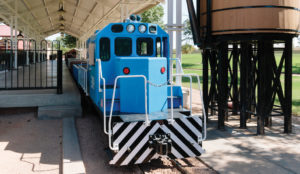 If you are looking for an affordable spot to take the whole family, listen up. We know at least one little girl who lives in Sedona and counts the McCormick-Stillman Railroad Park among her favorite spots in Arizona. The 30-acre park, which opened in 1975 and is located in the heart of Scottsdale, boasts the Paradise & Pacific Railroad, a vintage Allan Herschell carousel, the Scottsdale Railroad Museum, shops, playgrounds, ice-cream shops, a botanical garden and a 10,000-square-foot model-railroad building. Darryl Grimes, the park’s assistant recreation coordinator, says the park attracts visitors from far and near. “We’re a big attraction for families with kids from infants to kids age 7 or 8,” says Darryl. “Families can spend the day here without breaking the bank. But then there are the artifacts in the museum and the model-train building, which really appeal to adults.” One thing is for certain, the railroad is the park’s main attraction. Built and operated as an exact 5:12 reproduction of a Colorado narrow-gauge railroad, it features three steam locomotives, two diesel engines, an electric engine, several scale model cars, a turntable, a water tank, trestles and a train shed. The best part? Riding the train only costs $2. (All-day wrist bands with unlimited rides on the Paradise & Pacific, Arboretum Railroad and carousel are $10.) When you get tired of the train, head over to the restored Scottsdale Charros Carousel (named for a local service group). The carrousel was built in 1950 and is registered with the National Carousel Association. It includes 30 horses and two wheelchair chariots. The railroad and carrousel run continuously on weekends and every 30 minutes on weekdays. The park is located at 7301 E. Indian Bend Road in Scottsdale. It hosts Railfair 2018 on Oct. 6 and 7, and the very popular Holiday Lights throughout December. Entry is free, but there is a cost to ride the trains and carousel. For more information, visit therailroadpark.com or call 480-312-2312.
If you are looking for an affordable spot to take the whole family, listen up. We know at least one little girl who lives in Sedona and counts the McCormick-Stillman Railroad Park among her favorite spots in Arizona. The 30-acre park, which opened in 1975 and is located in the heart of Scottsdale, boasts the Paradise & Pacific Railroad, a vintage Allan Herschell carousel, the Scottsdale Railroad Museum, shops, playgrounds, ice-cream shops, a botanical garden and a 10,000-square-foot model-railroad building. Darryl Grimes, the park’s assistant recreation coordinator, says the park attracts visitors from far and near. “We’re a big attraction for families with kids from infants to kids age 7 or 8,” says Darryl. “Families can spend the day here without breaking the bank. But then there are the artifacts in the museum and the model-train building, which really appeal to adults.” One thing is for certain, the railroad is the park’s main attraction. Built and operated as an exact 5:12 reproduction of a Colorado narrow-gauge railroad, it features three steam locomotives, two diesel engines, an electric engine, several scale model cars, a turntable, a water tank, trestles and a train shed. The best part? Riding the train only costs $2. (All-day wrist bands with unlimited rides on the Paradise & Pacific, Arboretum Railroad and carousel are $10.) When you get tired of the train, head over to the restored Scottsdale Charros Carousel (named for a local service group). The carrousel was built in 1950 and is registered with the National Carousel Association. It includes 30 horses and two wheelchair chariots. The railroad and carrousel run continuously on weekends and every 30 minutes on weekdays. The park is located at 7301 E. Indian Bend Road in Scottsdale. It hosts Railfair 2018 on Oct. 6 and 7, and the very popular Holiday Lights throughout December. Entry is free, but there is a cost to ride the trains and carousel. For more information, visit therailroadpark.com or call 480-312-2312.
MUSICAL INSTRUMENT MUSEUM
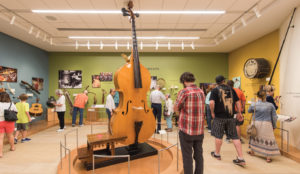 Heidi Richmond, the marketing manager at the Musical Instrument Museum in northern Phoenix, offers visitors a key piece of advice that we will readily echo: “Start your visit in the morning,” she says. “You don’t really know how much time you’re going to want to spend at the museum, so portion out a big chunk of your day. The average visitor spends 3.5 hours with us.” The world’s only global musical instrument museum encompasses 200,000 square feet and two floors. The collection includes 16,000 instruments and musical objects. The space is divided into geographical regions (we could spend hours in the Africa gallery), and each gallery is equipped with wireless technology and high-resolution video screens. What does this mean for you? Thanks to the headphones that you are handed when you purchase your admission ticket, not only will you see the instruments, you will also hear their sounds and watch them played in their native environment. We’re museum junkies, and MIM stands out as the most immersive museum experience we’ve had. Don’t miss the Artist Gallery where you’ll see instruments linked to world-renowned musicians. We’re talking the Steinway piano on which John Lennon composed Imagine and the Martin D-28 guitar Elvis played at his last concert performance. Aside from music fans, travelers will also appreciate the space, says Heidi. “It allows you to travel through cultures around the world without leaving Phoenix,” she says. MIM includes a 300-seat theater with state-of-the-art acoustics (the venue hosts 250 concerts a year that frequently feature Grammy-award-winning artists), an excellent café and a gift shop. MIM is located at 4725 E. Mayo Blvd. in Phoenix. It’s open daily, 9 a.m. to 5 p.m. Tickets are $20 for adults, $15 for teens ages 13 to 19, $10 for children ages 4 to 12 and free for children 3 and younger. For more details, visit mim.org or call 480-478-6000.
Heidi Richmond, the marketing manager at the Musical Instrument Museum in northern Phoenix, offers visitors a key piece of advice that we will readily echo: “Start your visit in the morning,” she says. “You don’t really know how much time you’re going to want to spend at the museum, so portion out a big chunk of your day. The average visitor spends 3.5 hours with us.” The world’s only global musical instrument museum encompasses 200,000 square feet and two floors. The collection includes 16,000 instruments and musical objects. The space is divided into geographical regions (we could spend hours in the Africa gallery), and each gallery is equipped with wireless technology and high-resolution video screens. What does this mean for you? Thanks to the headphones that you are handed when you purchase your admission ticket, not only will you see the instruments, you will also hear their sounds and watch them played in their native environment. We’re museum junkies, and MIM stands out as the most immersive museum experience we’ve had. Don’t miss the Artist Gallery where you’ll see instruments linked to world-renowned musicians. We’re talking the Steinway piano on which John Lennon composed Imagine and the Martin D-28 guitar Elvis played at his last concert performance. Aside from music fans, travelers will also appreciate the space, says Heidi. “It allows you to travel through cultures around the world without leaving Phoenix,” she says. MIM includes a 300-seat theater with state-of-the-art acoustics (the venue hosts 250 concerts a year that frequently feature Grammy-award-winning artists), an excellent café and a gift shop. MIM is located at 4725 E. Mayo Blvd. in Phoenix. It’s open daily, 9 a.m. to 5 p.m. Tickets are $20 for adults, $15 for teens ages 13 to 19, $10 for children ages 4 to 12 and free for children 3 and younger. For more details, visit mim.org or call 480-478-6000.
ODYSEA IN THE DESERT
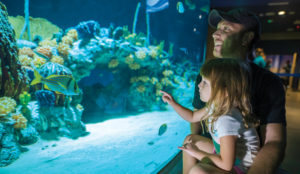 Who says you have to go west to experience the ocean? It’s a much quicker drive down to Scottsdale and OdySea in the Desert, located within the Salt River Pima-Maricopa Indian Community. OdySea is actually four attractions within one: OdySea Aquarium, Butterfly Wonderland, Dolphinaris Arizona and Pangaea Land of the Dinosaurs. Add to that restaurants highlighting international cuisine, shopping, rides and Vitality Aqua Massage & Oxygen Bar, and OdySea clearly isn’t just about the kiddies. “OdySea in the Desert is such a popular destination because it brings a myriad of entertainment to families, visitors and residents alike all in one destination,” says Ran Knishinsky, chief marketing officer. “Guests can explore Butterfly Wonderland and the 3,000 butterflies from around the world that fly freely. At OdySea Aquarium, guests get an underwater, up-close experience with sharks, stingrays, exotic fish, turtles, penguins, sea otters and others alongside the world’s only rotating aquatic experience, the OdySea Voyager. OdySea in the Desert features an ice bar at Polar Play, encounters with dinosaurs at Pangea Land of the Dinosaurs, real bodies at Bodies Revealed and other family-friendly activities.” The aquarium, which opened in 2016, features 67 exhibits, 6,000 animals and 370 species, but we’re partial to Butterfly Wonderland, which opened in 2013. It’s the country’s largest indoor butterfly pavilion. Your visit begins with a 3D movie about the life of the butterfly and culminates in a glass-enclosed atrium that mimics a rainforest environment. (There’s a new glass-art exhibit happening now, too.) The atrium is filled with thousands of butterflies that won’t think twice about landing on you, especially if you wear bright-colored clothing. Don’t miss the emergence gallery where you can observe the butterfly’s metamorphosis in real time. OdySea in the Desert is located at 9500 E. Via de Ventura in Scottsdale. It’s open 365 days a year (hours depend on the season, so check the website). Entrance fees to the aquarium range from $34.95 for adults to $24.95 for children ages 3 to 12. Entrance fees to Butterfly Wonderland range from $19.95 for adults to $12.95 for children 3 and older. For information on all of its attractions, visit odyseainthedesert.com.
Who says you have to go west to experience the ocean? It’s a much quicker drive down to Scottsdale and OdySea in the Desert, located within the Salt River Pima-Maricopa Indian Community. OdySea is actually four attractions within one: OdySea Aquarium, Butterfly Wonderland, Dolphinaris Arizona and Pangaea Land of the Dinosaurs. Add to that restaurants highlighting international cuisine, shopping, rides and Vitality Aqua Massage & Oxygen Bar, and OdySea clearly isn’t just about the kiddies. “OdySea in the Desert is such a popular destination because it brings a myriad of entertainment to families, visitors and residents alike all in one destination,” says Ran Knishinsky, chief marketing officer. “Guests can explore Butterfly Wonderland and the 3,000 butterflies from around the world that fly freely. At OdySea Aquarium, guests get an underwater, up-close experience with sharks, stingrays, exotic fish, turtles, penguins, sea otters and others alongside the world’s only rotating aquatic experience, the OdySea Voyager. OdySea in the Desert features an ice bar at Polar Play, encounters with dinosaurs at Pangea Land of the Dinosaurs, real bodies at Bodies Revealed and other family-friendly activities.” The aquarium, which opened in 2016, features 67 exhibits, 6,000 animals and 370 species, but we’re partial to Butterfly Wonderland, which opened in 2013. It’s the country’s largest indoor butterfly pavilion. Your visit begins with a 3D movie about the life of the butterfly and culminates in a glass-enclosed atrium that mimics a rainforest environment. (There’s a new glass-art exhibit happening now, too.) The atrium is filled with thousands of butterflies that won’t think twice about landing on you, especially if you wear bright-colored clothing. Don’t miss the emergence gallery where you can observe the butterfly’s metamorphosis in real time. OdySea in the Desert is located at 9500 E. Via de Ventura in Scottsdale. It’s open 365 days a year (hours depend on the season, so check the website). Entrance fees to the aquarium range from $34.95 for adults to $24.95 for children ages 3 to 12. Entrance fees to Butterfly Wonderland range from $19.95 for adults to $12.95 for children 3 and older. For information on all of its attractions, visit odyseainthedesert.com.
PHOENIX ART MUSEUM
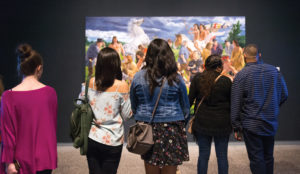 There’s a lot to see at the Phoenix Art Museum. A lot. Call us snobs, but we were surprised to discover that the collections in the 285,000-square-foot space hold their own with any major-metropolitan art museum. (It’s actually the largest art museum in the Southwest.) The installation that sealed the deal was Yayoi Kusama’s You Who Are Getting Obliterated in the Dancing Swarm of Fireflies, which has been part of the museum’s permanent collection since 2006. We would honestly make the drive to Phoenix just to sit inside this installation again. Luckily, there’s no limit on the amount of time you can spend inside, and it’s not ticketed. Inspired by a Japanese folktale about a person in a field with 10,000 fireflies, the exhibit is in a dark room lined with mirrors on every surface. Strands of looping LED lights are suspended from the ceiling. Though we’re told the room is small, the mirrors make it seem like you’re suspended in the center of the galaxy – or in a field full of fireflies at midnight. It’s disconcerting and deeply peaceful all at the same time. We actually had a hard time leaving. The exhibit that everyone is talking about right now is Teotihuacan: City of Water, City of Fire. It includes more than 200 objects excavated from the Teotihuacan site outside of Mexico City. We’re talking objects ranging in size from miniature figurines to stone sculptures that were on the outside of buildings. The collection made stops in San Francisco and Los Angeles, and Phoenix will be its final U.S. destination before it returns to Mexico in January 2019, says Margaree Bigler, public relations and digital communications manager for Phoenix Art Museum. Phoenix Art Museum opened in 1959. Today, its collection includes more than 19,000 works of modern and contemporary American, Asian, European and Latin American art and fashion design. Don’t miss the photography exhibit, part of a collaboration between the museum and the Center for Creative Photography in Tucson. You literally can’t miss Carlos Amorales’ Black Cloud installation of 25,000 black paper moths, which greets you when you enter the museum. Margaree’s tip for visitors? “Ask where the Thorne Rooms are,” she says. We’ll let you discover why. The museum is located at 1625 N. Central Ave. in Phoenix. It is open Tuesday, 10 a.m. to 5 p.m.; Wednesday, 10 a.m. to 9 p.m.; Thursday through Saturday, 10 a.m. to 5 p.m. (10 p.m. on the first Friday of the month); and Sunday, noon to 5 p.m. Admission is $23 for adults, $20 for senior citizens, $18 for students and $14 for children ages 6 to 17. Children ages 5 and younger, and past and present members of the military are admitted at no charge. The museum also offers free general admission Wednesday evenings from 3 to 9 p.m., first Fridays from 6 to 10 p.m. and the second weekend of each month. For more information, visit phxart.org or call 602-457-5814.
There’s a lot to see at the Phoenix Art Museum. A lot. Call us snobs, but we were surprised to discover that the collections in the 285,000-square-foot space hold their own with any major-metropolitan art museum. (It’s actually the largest art museum in the Southwest.) The installation that sealed the deal was Yayoi Kusama’s You Who Are Getting Obliterated in the Dancing Swarm of Fireflies, which has been part of the museum’s permanent collection since 2006. We would honestly make the drive to Phoenix just to sit inside this installation again. Luckily, there’s no limit on the amount of time you can spend inside, and it’s not ticketed. Inspired by a Japanese folktale about a person in a field with 10,000 fireflies, the exhibit is in a dark room lined with mirrors on every surface. Strands of looping LED lights are suspended from the ceiling. Though we’re told the room is small, the mirrors make it seem like you’re suspended in the center of the galaxy – or in a field full of fireflies at midnight. It’s disconcerting and deeply peaceful all at the same time. We actually had a hard time leaving. The exhibit that everyone is talking about right now is Teotihuacan: City of Water, City of Fire. It includes more than 200 objects excavated from the Teotihuacan site outside of Mexico City. We’re talking objects ranging in size from miniature figurines to stone sculptures that were on the outside of buildings. The collection made stops in San Francisco and Los Angeles, and Phoenix will be its final U.S. destination before it returns to Mexico in January 2019, says Margaree Bigler, public relations and digital communications manager for Phoenix Art Museum. Phoenix Art Museum opened in 1959. Today, its collection includes more than 19,000 works of modern and contemporary American, Asian, European and Latin American art and fashion design. Don’t miss the photography exhibit, part of a collaboration between the museum and the Center for Creative Photography in Tucson. You literally can’t miss Carlos Amorales’ Black Cloud installation of 25,000 black paper moths, which greets you when you enter the museum. Margaree’s tip for visitors? “Ask where the Thorne Rooms are,” she says. We’ll let you discover why. The museum is located at 1625 N. Central Ave. in Phoenix. It is open Tuesday, 10 a.m. to 5 p.m.; Wednesday, 10 a.m. to 9 p.m.; Thursday through Saturday, 10 a.m. to 5 p.m. (10 p.m. on the first Friday of the month); and Sunday, noon to 5 p.m. Admission is $23 for adults, $20 for senior citizens, $18 for students and $14 for children ages 6 to 17. Children ages 5 and younger, and past and present members of the military are admitted at no charge. The museum also offers free general admission Wednesday evenings from 3 to 9 p.m., first Fridays from 6 to 10 p.m. and the second weekend of each month. For more information, visit phxart.org or call 602-457-5814.
ROOSEVELT ROW
There isn’t any place in northern Arizona quite like Phoenix’s always-funky Roosevelt Row. Want to meet emerging artists? On the first and third Fridays in October, November and December from 6 to 10 p.m., you can pop into three shipping containers to see exhibitions. On any day of the week you can shop for vinyl at Revolver Records, listen to jazz at The Nash or you can check out one of our favorite spots, DeSoto Central Marketplace, for fresh oysters and classic cocktails. The best part? Most of the businesses are owner operated. “It’s such a walkable place,” says Greg Esser, artist and coowner of MADE Art Boutique. (Don’t miss Greg’s line of greeting cards made from recycled file folders.) “There are so many nooks and crannies. The best thing you can do is strike up a conversation with a local in a coffee shop and ask them about their favorite hot spot or part of the neighborhood.” The other best thing you can do is visit Roosevelt Row during the First Friday Art Walk. Greg says the area has attracted artists for decades, but in the early 2000s, it started to attract visitors from as far as California, especially on the first Friday of the month when you’re likely to see musicians, hip-hop dancers and spoken-word artists performing on street corners. That’s also when the A.R.T.S. Market takes place. The market happens on Roosevelt Street between 2nd and 5th streets and features fine art, handmade crafts, and vintage and culinary items. Depending on the time of the year, an art walk can attract up to 40,000 people, says Greg, who is also the founder of the Roosevelt Row Merchants Association. Roosevelt Row includes 30 to 40 restaurants, more than a dozen art studios that are open to the public and numerous boutiques. The neighborhood is roughly defined by 7th Avenue and 7th Street and within easy walking distance from the Valley Metro Rail stop at Central Avenue and Roosevelt Street. For more information, visit rooseveltrow.org or call 602-829-5259.
SHOPPING IN OLD TOWN SCOTTSDALE
Sure, Scottsdale Fashion Square is in the middle of a massive redevelopment project that will result in even more high-end brands coming to Arizona (hello, Saint Laurent), but Old Town Scottsdale is quintessential Arizona shopping. You might not find Gucci, but you will find galleries that have been in business for decades right beside fashionable new bars, wine-tasting rooms and carefully curated boutiques. Old Town is defined by Chaparral Road and Earll Drive to the north and south, and Miller Road and 68th Street to the east and west. Within that radius, you’ll find 150 restaurants (as of this writing, Blue Clover Distillery at 7042 E. Indian School Road was the newest), more than 35 bars and tasting rooms and scores of shops. Interspersed, discover pocket parks, public artwork, water fountains, bridges, a pink ice cream parlor that dates back to 1958 and benches perfect for people watching. “Scottsdale is a hub for shopping, full of one-of-a-kind specialty boutiques, art galleries and major retailers,” says Rachel Sacco, CEO and president of Experience Scottsdale. “In the various districts of Old Town Scottsdale, from the Scottsdale Arts District to the Fifth Avenue Shopping District, shoppers will find fine art, jewelry, vintage clothing, southern Arizona wine, smallbatch sweets and locally made products. Also in our downtown core, shoppers can peruse nearly 250 stores in Scottsdale Fashion Square, the largest shopping center in the Southwest. Shopping is one of the most popular activities for Scottsdale visitors.” For information about the shops and restaurants in Old Town, visit experiencescottsdale.com or call 480-421-1004. For details on the new Scottsdale Fashion Square Expansion, which is set to debut this fall, visit fashionsquare.com or call 480-568-5568.
TALIESIN WEST
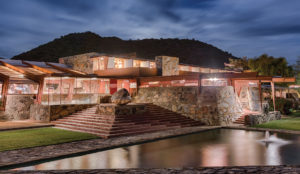 Like any savvy East Coaster, Frank Lloyd Wright knew that winters are just better in Arizona. That’s why he began building Taliesin (Tall-EEE-essin) West at the base of the McDowell Mountains in 1938. (Taliesin, the home Wright built with his client and mistress Mamah Borthwick, is located in Spring Green, Wisconsin.) Taliesin West, more of a winter camp than a winter home, still houses the Frank Lloyd Wright Foundation and Frank Lloyd Wright School of Architecture. Lucky for us, it’s also open to the public for tours. Taliesin is a Welsh word meaning “shining brow,” says Jeff Goodman, director of marketing and communication for the Frank Lloyd Wright Foundation. Wright believed you shouldn’t build on top of a hill but rather into the brow of the hill so that the building complements the environment rather than dominates it. “We don’t consider Taliesin West a house museum because house museums live in the past,” says Jeff. “We believe the only true way to understand Frank Lloyd Wright’s work is to experience it. Sit in the furniture to understand how he framed the views of the desert and brought the outdoors in. Play the piano to hear the acoustics. Stand in the breezeway to feel the cooling effect of the breeze. Maybe you’ll come up with your own ideas to incorporate into your home and life.” Depending on the time of the year, Taliesin West offers several tour opportunities ranging from 90 minutes to more than three hours. Looking for a date-night idea? Check out the Night Lights Tour, which allows you to see Taliesin West’s tent-like buildings glowing in the twilight. You’ll also be treated to an appearance by the home’s fire-breathing dragon. Taliesin West is located at 12621 N. Frank Lloyd Wright Blvd. in Scottsdale. It’s open year-round, but hours vary by season. Tours range from $35 to $75 for adults. The Night Lights Tour is offered Friday and Saturday at 6:30 and 7 p.m. Tickets are $45. Reservations are required or strongly recommended for all tours. For more information, visit franklloydwright.org or call 480-860-2700.
Like any savvy East Coaster, Frank Lloyd Wright knew that winters are just better in Arizona. That’s why he began building Taliesin (Tall-EEE-essin) West at the base of the McDowell Mountains in 1938. (Taliesin, the home Wright built with his client and mistress Mamah Borthwick, is located in Spring Green, Wisconsin.) Taliesin West, more of a winter camp than a winter home, still houses the Frank Lloyd Wright Foundation and Frank Lloyd Wright School of Architecture. Lucky for us, it’s also open to the public for tours. Taliesin is a Welsh word meaning “shining brow,” says Jeff Goodman, director of marketing and communication for the Frank Lloyd Wright Foundation. Wright believed you shouldn’t build on top of a hill but rather into the brow of the hill so that the building complements the environment rather than dominates it. “We don’t consider Taliesin West a house museum because house museums live in the past,” says Jeff. “We believe the only true way to understand Frank Lloyd Wright’s work is to experience it. Sit in the furniture to understand how he framed the views of the desert and brought the outdoors in. Play the piano to hear the acoustics. Stand in the breezeway to feel the cooling effect of the breeze. Maybe you’ll come up with your own ideas to incorporate into your home and life.” Depending on the time of the year, Taliesin West offers several tour opportunities ranging from 90 minutes to more than three hours. Looking for a date-night idea? Check out the Night Lights Tour, which allows you to see Taliesin West’s tent-like buildings glowing in the twilight. You’ll also be treated to an appearance by the home’s fire-breathing dragon. Taliesin West is located at 12621 N. Frank Lloyd Wright Blvd. in Scottsdale. It’s open year-round, but hours vary by season. Tours range from $35 to $75 for adults. The Night Lights Tour is offered Friday and Saturday at 6:30 and 7 p.m. Tickets are $45. Reservations are required or strongly recommended for all tours. For more information, visit franklloydwright.org or call 480-860-2700.


